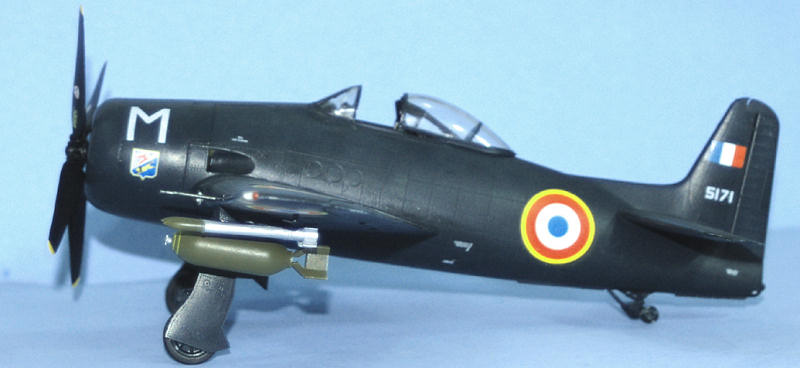
Trumpeter 1/32 F8F-1B Bearcat
| KIT #: | 02284 |
| PRICE: | $84.95 |
| DECALS: | Two options |
| REVIEWER: | Tom Cleaver |
| NOTES: | Eduard Bearcat Interior photoetch set used. |

| HISTORY |
Everyone who ever flew a Bearcat
loved it. Legendary British test
pilot Captain Eric Brown recalled that when he was assigned to the Naval Air
Test Center at NAS Patuxent River,
Marion Carl would do loops on takeoff, landing back on the runway out of the
loop, in a Bearcat, it had that much excess power.
Brown himself couldn’t decide whether he liked the Bearcat more than the
Sea Fury, but definitely considered the F8F to be the best American
piston-engine fighter he ever flew.
Grumman test pilot Corky Meyer, who flew every airplane Grumman ever made from
the F4F onward, liked the Bearcat best.
As Meyer explained it to me several years ago, the Bearcat was the
offspring of the marriage of a Gee Bee to a Focke-Wulf Fw-190.
Bob Hall, who designed the F8F, had come to Grumman from working with the
Granville Brothers, where he had an important hand in the design of the Gee Bee
racers. As such, he was a strong
advocate of putting the biggest, most powerful engine available into the
smallest airframe that could carry it.
In 1943, Hall test-flew an Fw-190A-5, which he immediately fell in love
with for its marvelous handling abilities.
He returned to
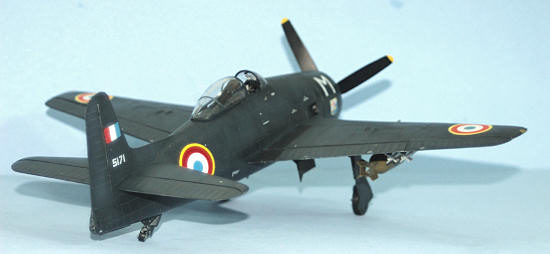 As it turned out, Hall was pulling an idea out of the Zeitgeist.
The Fighter Desk at the Bureau of Aeronautics was staffed by former
fighter pilots who had cut their teeth on airplanes like the Boeing F4B-4 -
which was so maneuverable a pilot could turn it by sticking his arm out of the
cockpit - and the Grumman F2F and F3F fighters.
While everyone was happy with the Hellcat, which was just embarking on
its career of scything the Japanese out of the skies over the Pacific, everyone
wished they were dealing with a smaller, lighter, more high-powered fighter that
could take on the Japanese fighters and out-fly them.
As it turned out, Hall was pulling an idea out of the Zeitgeist.
The Fighter Desk at the Bureau of Aeronautics was staffed by former
fighter pilots who had cut their teeth on airplanes like the Boeing F4B-4 -
which was so maneuverable a pilot could turn it by sticking his arm out of the
cockpit - and the Grumman F2F and F3F fighters.
While everyone was happy with the Hellcat, which was just embarking on
its career of scything the Japanese out of the skies over the Pacific, everyone
wished they were dealing with a smaller, lighter, more high-powered fighter that
could take on the Japanese fighters and out-fly them.
Hall decided to put a Pratt and Whitney R-2800, the finest radial engine
ever built, into the smallest possible airframe that could carry the engine.
The G-58 was a “copy” of the Fw-190 in design philosophy, though no part
of the German fighter was actually copied.
The engine was closely-cowled in the manner of the Wurger, and the
airplane had a wide-track undercarriage that greatly eased carrier landings.
The new airplane also bettered the outstanding visibility of the German
fighter through the use of a “bubble” canopy that was so perfectly designed it
did not create drag.
The end result was 20 percent lighter than a Hellcat, with a 30% better
climb rate, and a top speed 50 mph faster, with outstanding maneuverability.
The first prototype was ordered in November 1943 flew on
The Navy ordered 2,023 F8F-1s immediately after the competition, while
the prototype underwent carrier trials in February 1945.
In March 1945 VF-18 and VF-19 were commissioned on Bearcats and underwent
intensive training to prepare them for combat in the coming invasion of
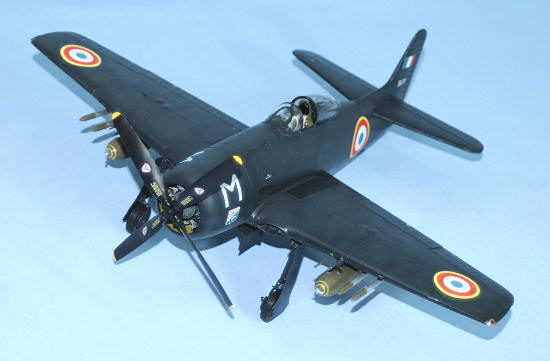 The Navy canceled nearly every production contract following V-J Day,
other than for the F8F-1 Bearcat and the F4U-4 Corsair.
While the numbers were cut to 1,200, the F8F was still the major Navy
fighter and in the next two years it equipped no less than 24 squadrons.
In 1946, an unmodified F8F-1 set a time-to-climb record - including a
takeoff run of 115 feet - getting to 10,000 feet in 94 seconds, a record that
stood for ten years until it was broken by a jet fighter, which was unable to
match the Bearcat's takeoff performance.
In tests with a P-80 assigned to
The Navy canceled nearly every production contract following V-J Day,
other than for the F8F-1 Bearcat and the F4U-4 Corsair.
While the numbers were cut to 1,200, the F8F was still the major Navy
fighter and in the next two years it equipped no less than 24 squadrons.
In 1946, an unmodified F8F-1 set a time-to-climb record - including a
takeoff run of 115 feet - getting to 10,000 feet in 94 seconds, a record that
stood for ten years until it was broken by a jet fighter, which was unable to
match the Bearcat's takeoff performance.
In tests with a P-80 assigned to
The performance of the Bearcat was still so outstanding that the airplane
replaced the Hellcat when the Blue Angels Air Demonstration Team was made a
permanent organization in 1948, and flew with the team for two seasons until
replaced by the F9F-2 Panther.
Service pilots had not been particularly happy about the light armament,
so a cannon-armed Bearcat was created with four 20 millimeter cannon instead of
four 50-caliber machine guns, under the designation "F8F‑1B." These were
produced in parallel with the F8F‑1, with 226 built.
100 F8F-1Bs were provided to the French Air Force for service in
The Bearcat Goes To War:
In 1944, President Franklin D. Roosevelt decided that the United States
would not support the post-war re-occupation of colonial empires in Asia by
Great Britain, France and the Netherlands, in recognition of the fact the war
had been fought to opposed Japanese imperialism, and that the United States was
committed to decolonialization around the world.
Unfortunately, the death of
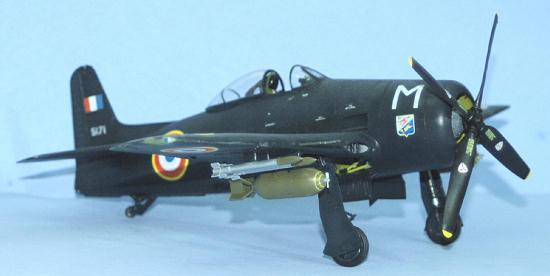 While nearly all Southeast Asian independence movements had collaborated
with the Japanese under the “Greater
While nearly all Southeast Asian independence movements had collaborated
with the Japanese under the “Greater
Unfortunately, with the death of Roosevelt and the focus of the United
States in the Pacific on dealing with the Japanese Home Islands, the British
were able to secure American acquiescence in the use of Commonwealth forces to
take the surrender of Japanese forces in Southeast Asia, thus guaranteeing
European colonialist domination of the region.
When the British arrived in Vietnam in the summer of 1945, they
completely ignored the Vietnamese independence forces, and in fact re-armed
Japanese troops who had surrendered to the Viet-Minh as “peace-keepers,” pending
the arrival of French forces.
The French arrived in the fall of 1945, to find that the Vietnamese
considered themselves independent of the French Empire.
By early 1946, hostilities broke out.
At the time, the United States was not prepared to support the French
claim, and the French forces could only use old equipment that had been provided
during the war.
Following the outbreak of the Korean War and the domestic rise of Senator
Joe McCarthy in opposition to the
Truman Administration, the argument was made by the French that they were
fighting the same forces in Indochina that the United States was fighting in
Korea, basing their argument on the idea that “Communism” was a monolithic
worldwide movement. With a domestic
need to appear “Tough on Communism,” the Truman Administration agreed with this
argument, and a Mutual Defense Assistance Agreement was signed between the
United States and France on December 23, 1950, which provided for provision of
additional military equipment by the United States.
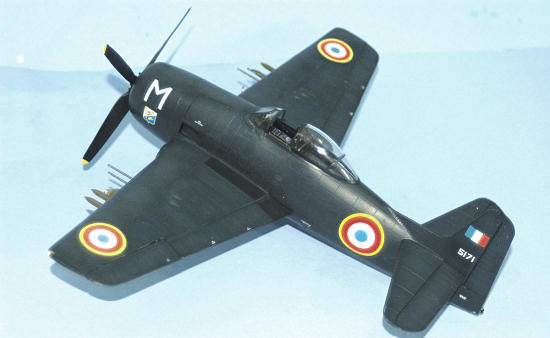 Among the items of military equipment provided were Grumman F8F-1B
fighter bombers that were now surplus to U.S. Navy requirements, which would
replace the ragtag collection of aircraft including the P-63 King Cobra, the SBD
Dauntless, and the Supermarine Spitfire then being used by the Armee d’ l’Air
units. The French units GC 1/8, GC
2/8, GC 2/9, and GC 1/21 used these Bearcats in the fighter‑bomber role against
the Viet Minh. With its high power,
the Bearcat was extremely useful in providing air support in the narrow valleys
of northern and central Vietnam, though its ordnance load was very limited,
which led to the French request for a better ground support aircraft that would
lead to the production of the F4U-7 Corsair.
Among the items of military equipment provided were Grumman F8F-1B
fighter bombers that were now surplus to U.S. Navy requirements, which would
replace the ragtag collection of aircraft including the P-63 King Cobra, the SBD
Dauntless, and the Supermarine Spitfire then being used by the Armee d’ l’Air
units. The French units GC 1/8, GC
2/8, GC 2/9, and GC 1/21 used these Bearcats in the fighter‑bomber role against
the Viet Minh. With its high power,
the Bearcat was extremely useful in providing air support in the narrow valleys
of northern and central Vietnam, though its ordnance load was very limited,
which led to the French request for a better ground support aircraft that would
lead to the production of the F4U-7 Corsair.
Following the French defeat at Dien Bien Phu in 1954, the 70 surviving Bearcats were passed to the Viet Nam Air Force when it was created in 1955. By 1961, these aircraft were pretty much worn out, and they were then replaced by the arrival of ex-U.S. Navy A-1 Skyraiders following the decision by President Kennedy to escalate U.S. involvement in the war in Viet Nam. Yours truly saw a few of these worn-out Bearcats at Tan Son Nhut Air Base when I first arrived Vietnam in the summer of 1963.
| THE KIT |
The Bearcat has been popular with plastic kit manufacturers for more than
40 years. Testors released their
1/48 F8F-2 Bearcat in 1967 and it was the standard for 1/48 kits for 30 years.
Monogram released an F8F-1B in 1969 that is still accurate, though one would
have to scratchbuild a cockpit and the accessories section that can be seen in
the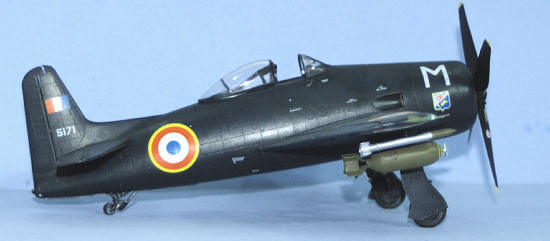 wheel
well. Frog also produced a Bearcat
in the early 1970s. Hobbycraft
brought out a series of Bearcats starting in 1997 that only bested the old
Testors kit by having a better cockpit, though its outline accuracy left
something to be desired. In 1/32,
both Combat Models and ID Models released vacuformed kits that are primarily
shells to be filled with the modeler’s scratchbuilding prowess.
wheel
well. Frog also produced a Bearcat
in the early 1970s. Hobbycraft
brought out a series of Bearcats starting in 1997 that only bested the old
Testors kit by having a better cockpit, though its outline accuracy left
something to be desired. In 1/32,
both Combat Models and ID Models released vacuformed kits that are primarily
shells to be filled with the modeler’s scratchbuilding prowess.
This new series of Bearcats from Trumpeter - which includes the F8F-1,
F8F-1B and F8f-2 - beats them all. This F8F-1B kit has
366 parts on 11 trees, with two additional trees in clear plastic, rubber
main gear tires and photo-etched that includes
an instrument panel face and seatbelt and shoulder harness.
This last bit is best replaced with the Eduard photoetch US seatbelts,
which are far easier to use and more realistic in their final look, while the
Eduard Bearcat interior set brings great detail to the rest of the cockpit.
Decals are provided for one French Air Force F8F-1B and one Thai Air
Force F8F-1D, both painted in Glossy Sea Blue.
| CONSTRUCTION |
In terms of kit design, the model presents no construction difficulties.
The various panels that can be displayed open also can be displayed
closed without any pushing and shoving to get them into position.
The separate controls will fit in the neutral position for ailerons and
elevators and the up position for the flaps, though it is not difficult to
modify the attachments to display them more dynamically if one wishes.
The various panels for the accessories section and the gun bays will
allow a modeler who wants to detail these areas to show them off, while what is
there in the box for these sections is a very good starting place for
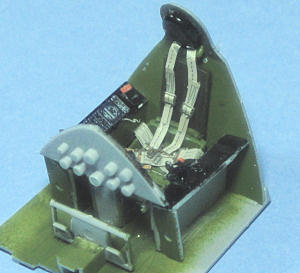 super-detailing.
The cowling, which finally has the accurate shape for the Bearcat, is
molded clear and could be left such to display the engine.
super-detailing.
The cowling, which finally has the accurate shape for the Bearcat, is
molded clear and could be left such to display the engine.
The engine provides the parts to do both the R-2800-34W that the F8F-1
used, and the R-2800-30W used by the F-8F-1B and the R-2800-57C used by the
F8F-2. Trumpeter has been doing the
R-2800 for quite awhile now, and the engine makes up so nice that it is a model
itself.
The accessories section, which is seen through the open gear wells, is
well-appointed and can be assembled right out of the box to “look right”, though
a modeler could include electrical wiring and such.
It is important here to note that Trumpeter’s painting instructions are
incorrect. I checked with my old
friend Corky Meyer, who has been around more Bearcats than anyone else alive.
He told me that the interior of the cowling and the accessory section is
Yellow Zinc Chromate, while the gear wells in the wing, the gear and the gear
doors, were all Glossy Sea Blue.
The cockpit has nice detail, but using the instrument panels and
seatbelts from the Eduard interior set will vastly improve
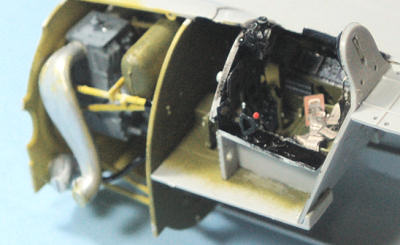 the final
look, which I did. I think the
photoetch instrument panel with the filmstrip instrument faces is more accurate
looking than the clear plastic parts.
the final
look, which I did. I think the
photoetch instrument panel with the filmstrip instrument faces is more accurate
looking than the clear plastic parts.
I assembled the wings to the fuselage halves before further assembling
the fuselage, so that I could work on the joint from both sides of the fuselage
part, which insured a good fit without having to use any gap-filler.
The wings can be assembled folded, and Trumpeter provides all the parts
necessary to do this and have a good-looking result.
I elected to assemble the control surfaces in the neutral position since I know the control stick is spring-loaded on a Bearcat and this is the position they normally take when the airplane is parked on the ground.
| COLORS & MARKINGS |
Painting:
The model was painted with an overall coat of Xtracrylix “Glossy Sea
Blue,” which I think is the best
Decals:
I went through the decal dungeon and found better roundels and a better tricolor, which I used with the kit decals for the squadron and aircraft markings. SPADA makes a decal sheet for French Bearcats that I would recommend as they are far better than what comes with the kit.
| FINAL CONSTRUCTION |
Since these airplanes were used in the tropics, the Glossy Sea Blue paint
did weather, with the paint fading and going “flat” in areas exposed to the sun.
I recreated this by adding in Xtracry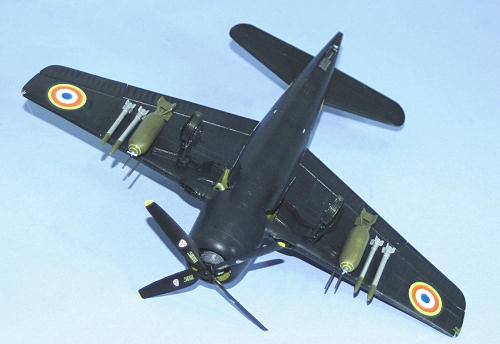 lix
“Intermediate Blue” to the “Glossy Sea Blue” and blotching various areas,
followed by an overall coat of Xtracrylix Flat Varnish, which dries in a “not
quite flat” finish, to which I then added Tamiya “Flat Base” and blotched the
overall surface to add to the weathering.
I also added exhaust stains with Tamiya “Smoke.”
Looking at photos of Bearcats in Indochina in the Google Life Magazine
collection, one can see Bearcats in the same unit that vary in finish from those
that are still relatively glossy to airplanes that are dead flat and faded, so
there is lots of room for a modeler’s creativity here.
lix
“Intermediate Blue” to the “Glossy Sea Blue” and blotching various areas,
followed by an overall coat of Xtracrylix Flat Varnish, which dries in a “not
quite flat” finish, to which I then added Tamiya “Flat Base” and blotched the
overall surface to add to the weathering.
I also added exhaust stains with Tamiya “Smoke.”
Looking at photos of Bearcats in Indochina in the Google Life Magazine
collection, one can see Bearcats in the same unit that vary in finish from those
that are still relatively glossy to airplanes that are dead flat and faded, so
there is lots of room for a modeler’s creativity here.
I unmasked the canopy, and attached the landing gear and propeller. I
posed the canopy in the open position.
I decided not to attach the drop tank, since most photos of Bearcats in
Indochina do not show it used. The
kit lacks sway braces for the bombs, so I used Evergreen strip to make
replacements, and used rockets from the Trumpeter Hellcat kit, since they look
better than what comes with the kit.
| CONCLUSIONS |
Trumpeter’s Bearcat series are the best Bearcats available in any scale.
The cockpit will look good out of the box using the photoetch seatbelts
provided. I would personally use
the SPADA decal sheet for French Bearcats if I did this again.
There is also a decal sheet available from a Thai source that provides
some very colorful Thai Bearcats.
The kit presents no problems in assembly and looks good when completed.
Thanks to Stevens
International for the review kit.
Thanks to Eduard for the photoetch interior set.
February 2010
If you would like your product reviewed fairly and quickly, please contact me or see other details in the Note to Contributors.